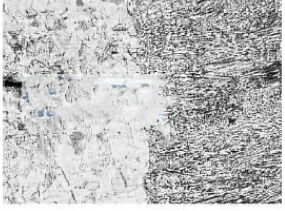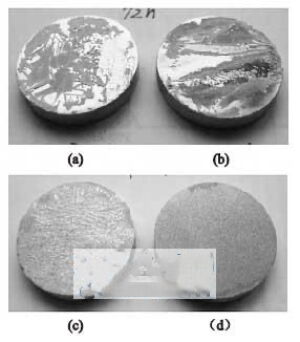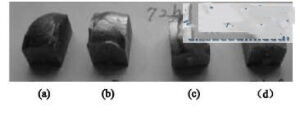Globe valves are widely used in nuclear power plant pipeline systems due to their minimal mechanical wear on the sealing surface and ease of maintenance. However, nuclear-grade stainless steel globe valves in nuclear power plants exhibit noticeable rust on the cladding’s sealing surface, which has compromised the valve's quality.
The causes of rust on the cladding sealing surface of nuclear-grade stainless steel globe valves are analyzed from three main aspects:
- Analyze the chemical composition of the valve body and sealing surface to determine if any adverse changes have occurred.
- Analyze the chemical composition of the grinding steel brush to determine if it has caused contamination of the stainless steel sealing surface.
- Analyze the impact of process technologies on the valves, such as welding and grinding.
2.1 Valve Body and Sealing Surface Materials
A DN15
stainless steel globe valve (Z2CND18-12NS) was selected, and the chemical composition of the valve body and sealing surface materials was analyzed using a spectrometer and final analysis. The test results indicate that the chemical composition of the valve body and sealing surface meets the RCC-MM3301 requirements, and no adverse changes have occurred.
The chemical composition of the grinding steel brush was analyzed using a spectrometer and final analysis. The analysis results indicate that the steel brush is made from an Fe-Cr-Mn austenite and martensite duplex stainless steel. The use of stainless steel brushes to grind stainless steel valves meets the requirements of RCC-M standards. The stainless steel brushes made from the same material are also used for manual grinding in the production of similar valves, and no rust have been observed on the sealing surface. Chemical composition analysis shows that the stainless steel brush has a high Mn content, which can improve the material's wear resistance.
The cladding of the sealing surface of the nuclear-grade stainless steel globe valve has undergone a welding process assessment, and the welding process assessment report meets the requirements of the RCC-M standard. The metallographic inspection results of the sealing surface show that the metallographic structure of the fusion welding zone is good, the heat-affected zone is primarily austenite, and the fusion welding zone contains typical columnar crystals formed by cooling. This indicates that the fusion welding process of the sealing surface is normal and the metallographic structure after welding is qualified. Therefore, it is concluded that the influence of the welding process on the quality of the sealing surface is excluded.

Figure 1 Metallographic structure of the fusion welding zone of the sealing surface with a magnification of 100 times
Influence of Grinding on the Microstructure and Chemical Composition of the Valve
Samples of the valve body substrate were selected for scanning electron microscopy analysis and chemical composition analysis after manual brush grinding, electric brush grinding, and wheel grinding (Figure 2). The analysis results show that the surface of manual grinding is relatively smooth, the surface of electric brush grinding is moderately rough, and the surface of wheel grinding is the roughest.
Please note that the positions marked with letters and the white line area are the detection areas for chemical composition.

(a) Electric brush grinding (b) Wheel grinding (c) Manual brush grinding
Figure 2 Microscopic morphology of valve substrate surface treated by different grinding processes
Comparing the chemical composition of the valve body, the surface chemical composition of the sample after wheel grinding and manual grinding is essentially the same as the chemical composition of the substrate material, while the Mn content of the sample surface after electric brush grinding is significantly increased. Comparing the chemical composition of the steel brush, the Mn content of the surface protrusions of the sample after electric brush grinding is close to that of the electric steel brush. This indicates that high-speed electric brush grinding destroys the passivation film on the material's surface and embeds tiny debris from the steel brush into the grinding surface.
Based on the actual working environment of nuclear-grade stainless steel globe valves at nuclear power sites, Na2SO4 + NaCl corrosive liquid was selected to simulate atmospheric corrosion conditions. Samples treated by four grinding processes—manual brush grinding, electric brush grinding, wheel grinding, and electric brush grinding followed by shot peening—were selected to simulate valve substrates. The samples were immersed in Na2SO4 + NaCl solution for 72 hours to simulate atmospheric corrosion tests (Figure 3). The corrosion results showed that rust spots appeared on the valve substrate samples treated with electric brush grinding, while there were no rust spots on the samples treated with other grinding processes. This indicates that the electric brush grinding process is one of the main causes of rust on the sealing surface of nuclear-grade stainless steel globe valves.

(a)Manual brush grinding (b) Electric brush grinding (c) Wheel grinding (d) Electric brush shot peening
Figure 3 Macromorphology of valve body samples treated with different grinding processes after simulated atmospheric corrosion
The original surface of the sealing surface and the samples treated with three grinding processes—manual brush grinding, electric brush grinding, and wheel grinding—were immersed in Na2SO4 + NaCl solution for 72 hours to simulate atmospheric corrosion tests (Figure 4). The corrosion results show that rust spots appeared on the samples treated with electric brush grinding, while no rust spots appeared on the samples treated with other grinding processes. This indicates that the electric brush grinding process is one of the main reasons for the rust on the sealing surface of the stainless steel globe valve.

(a)Original surfaces (b) Manual brush grinding (c) Electric brush grinding (d) Wheel grinding
Figure 4 Macromorphology of the sealing surface treated by different grinding processes after simulated atmospheric corrosion
By analyzing the chemical composition of the valve body and the sealing surface, it was observed that their chemical compositions had not undergone adverse changes. By analyzing the chemical composition of the steel brush used for grinding, it was determined that the steel brush is composed of Fe-Cr-Mn austenite and martensite duplex stainless steel and does not cause pollution to the stainless steel globe valve. Through process analysis, the influence of the welding process on the quality of the sealing surface was ruled out. Rust spots appeared on the samples treated with electric brush grinding, while no rust spots appeared on the samples treated with other grinding processes, including those treated with electric brush grinding followed by shot peening. This indicates that the electric brush grinding process is the main cause of rust on the sealing surface of the stainless steel globe valve. Brush grinding destroys the passivation film and partially transfers tiny debris from the steel brush, which becomes embedded and bonded to the grinding surface, affecting the re-passivation of the valve substrate. In the humid environment of coastal nuclear power plants, the steel brush debris interacts with the valve substrate, leading to rust.
Aiming at the rust issue of the sealing surface of nuclear-grade stainless steel globe valves, the grinding process was improved. The arc closing part of the sealing surface and the welding seam surface were polished with 120# sandpaper or 60# cloth wheel. Pay attention to the smooth transition of the surface during grinding, and no obvious grinding marks are allowed. At the same time, the sandpaper and soft cloth used for grinding cannot be reused. Gloves must be worn when grinding with sandpaper to avoid direct contact between hands and products to prevent contamination of the products. After grinding, pickling, passivation and cleaning, visually check whether there are still residual welding oxidation discoloration layers and defects on the surface of the sealing surface. If these two conditions are found on the surface, 60# sandpaper must be used to grind and clean it until it is removed, and the visual inspection is qualified. The valves treated with the new grinding process were immersed in Na2S04 + NaCl solution for 72 hours in a simulated atmospheric corrosion test, and no rust was found. After the new process was adopted, no rust was found in the nuclear-grade stainless steel globe valves used in nuclear power plants.
With the rapid development of the nuclear power industry, various valve manufacturers are also actively exploring how to improve the process and improve work efficiency. However, while actively exploring and improving the process, they should also strengthen process testing and evaluation to avoid the impact of the process used on the quality of nuclear power site equipment.



